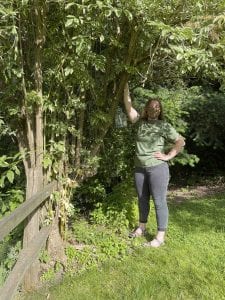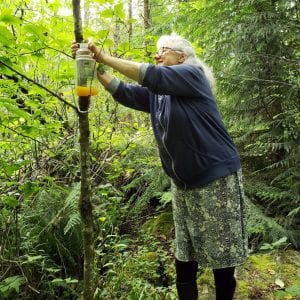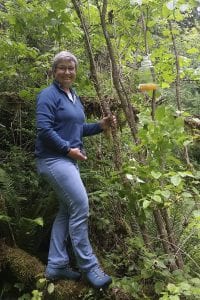Mobilizing Community: Whatcom Land Trust Monitors for Asian Giant Hornets
When the invasive Asian large hornet (Vespa mandarinia), dubbed “homicide hornets” in nationwide headlines, was found in close by British Columbia, the Pacific Northwest – and Whatcom County particularly – went on alert. Able to quickly increasing and wiping out already endangered North American bee populations, provincial and Canadian authorities companies, native, state and federal companies, nonprofits and beekeepers have made colossal, coordinated efforts to search out and cease the hornet invaders, earlier than they may unfold any additional.
The US Division of Agriculture (USDA), in collaboration with the Washington State Division of Agriculture (WSDA), has known as on the general public to assist. The Bellingham-based nonprofit Whatcom Land Belief was considered one of many conservation organizations that mobilized their crew of citizen scientists final summer season to trace and forestall the unfold of this invasive species in Whatcom County. This 12 months, these efforts proceed within the hope that we as a neighborhood can shield native bee populations and their very important position as pollinators on farms and in our endangered pure setting.
One other hit for an already fragile system
Earlier than Asian large hornets arrived on the Salish coast, bees throughout North America had been in severe hazard. In keeping with the Middle for Organic Range, greater than half of the 4,000 native bee species in North America had been already in decline, with one in 4 species threatened with extinction. A 2019 survey by the Bee Knowledgeable Partnership discovered that just about 40% of U.S. beekeepers misplaced their colonies up to now 12 months. In comparison with 1947, the variety of honeybees in america had decreased by 60%. These declines had been prompted partially by a mix of things resembling pesticide sensitivity, habitat decline, the unfold of mite and fungal ailments, and the nonetheless mysterious colony collapse dysfunction.
 Rand Jack, a founding and present board member of the Whatcom Land Belief, is reviewing a lure on the belief’s property in the summertime of 2020. Copyright: Jennifer Mackey
Rand Jack, a founding and present board member of the Whatcom Land Belief, is reviewing a lure on the belief’s property in the summertime of 2020. Copyright: Jennifer Mackey
Harm to North American bee populations will have an effect on the US $ 15 billion price of meals crops that bees pollinate annually. Nationwide and world meals safety, associated jobs and our agriculture might have severe long-term penalties.
Asian large hornets in Whatcom County
Scientists already knew the hazards of the hornets. They knew {that a} single group of Asian large hornets can assault and completely destroy a number of beehives inside a couple of hours. Their sharp mandibles (jaws) shortly decapitate hundreds of bees. Then they accumulate carcasses and rising bee larvae and transport them again to their nest to feed their very own younger. The nickname homicide hornets happened as a result of they will additionally kill folks, for instance in Japan as much as 50 per 12 months.
 Whatcom Land Belief Workplace director Kristy Lee hangs the primary lure this season within the Belief workplace in Downtown Bellingham. Picture credit score: Jennifer Mackey
Whatcom Land Belief Workplace director Kristy Lee hangs the primary lure this season within the Belief workplace in Downtown Bellingham. Picture credit score: Jennifer Mackey
A nest of Asian large hornets was first found and destroyed in August 2019 on Vancouver Island in Nanaimo, BC. The hornets most likely got here to East Asia as stowaways on container ships from their dwelling territory in northern India. The primary proof of their arrival in Custer, WA – devastated beehives – was found in November and December 2019.
The WSDA abruptly confronted an amazing effort throughout a world pandemic, and it couldn’t reply with out a lot assist. In Whatcom County alone, they needed to monitor greater than 2,500 sq. miles for particular person hornets and their nests – like on the lookout for a hornet in a haystack. The Could 2020 name was for citizen scientists – public volunteers – to assist seize these undesirable intruders and hopefully discover their nests earlier than they may unfold.
Whatcom Land Belief (The Belief) was a part of many conservation teams and hundreds of people who set and monitored traps on a weekly foundation. These efforts ultimately led to the invention of the primary nest in america southeast of Blaine in October 2020. A small nest with about 500 people was destroyed only some days later and picked up for analysis functions.
This 12 months, starting July 1, the intensive surveillance efforts will proceed with even higher urgency. Scientists do not know what number of nests there are in our space. Some surprise if we will cease the unfold earlier than it overwhelms the Pacific Northwest and past, just like the gypsy moth, zebra mussel, and so many different invasive species.
Whatcom Land Belief Monitoring Efforts
Whatcom Land Belief’s mission was already nicely aligned with the USDA and WSDA’s aim of defending pollinators. For the previous 20 years, the Belief has secured curiosity in land and promoted its administration to protect and shield the wildlife habitats, scenic, agricultural and open land in Whatcom County for future generations. Now that the belief has protected greater than 24,000 acres of land in Whatcom County, together with greater than 1,800 acres of agricultural land being labored by Whatcom County farmers, the belief might present many hornet monitoring websites. The Belief additionally already had a crew of Citizen Scientists engaged on the restoration and monitoring of its properties.
 Citizen scientist Monique Brewer monitored a dozen traps on Whatcom Land Belief properties final 12 months. Picture credit score: Jennifer Mackey
Citizen scientist Monique Brewer monitored a dozen traps on Whatcom Land Belief properties final 12 months. Picture credit score: Jennifer Mackey
Stewardship Director Jennifer Mackey was fast to mobilize the neighborhood to affix the hassle.
“Final 12 months, our Citizen Scientists monitored about 50 Asian large hornet traps on numerous Whatcom Land Belief-protected properties each week between July and November 2020 – a interval of twenty-two weeks,” says Mackey. “Happily for the bees, we did not discover any of those hornets final 12 months. This 12 months we’ll use an analogous however simplified methodology and all supplies can be offered by the WSDA. “
Additionally this summer season and fall, greater than 40 Belief Citizen Scientists will monitor greater than 30 traps throughout many Land Belief properties. “Primarily based on final 12 months’s science, our traps can be positioned nearer to the county’s west coast this 12 months,” says Mackey. “We lately acquired extra properties in California Creek, Blaine, so we could have a number of traps there this 12 months. Most of our traps are on belief properties that don’t have public entry. Some are additionally in upkeep servitude with personal landowners. ”
The traps and their surveillance usually are not refined. Made out of two-liter plastic bottles, the traps are baited with orange juice and cooked rice wine to draw hornets however to discourage native species, after which hung in timber. Areas are logged by way of a cellphone app and the content material is loaded weekly after which reset with contemporary bait. This 12 months, the contents of the lure solely must be photographed and despatched if an Asian large hornet is found or suspected.
 Traps are baited with orange juice and rice cooking wine, which attracts hornets however discourages native species, after which hung in timber. Picture credit score: Jennifer Mackey
Traps are baited with orange juice and rice cooking wine, which attracts hornets however discourages native species, after which hung in timber. Picture credit score: Jennifer Mackey
Though the WSDA will welcome samples from citizen scientists from throughout Washington state, its focus is on Whatcom, Skagit, Island, San Juan, Snohomish, King, Jefferson, and Clallam Counties.
The general public is invited to affix an Asian Big Hornet Watch Fb group and WSDA e-newsletter for ongoing updates.
Resolve issues with the assistance of Citizen Sciencee
Longtime belief donor and volunteer Monique Brewer was considered one of greater than 40 Citizen Scientists who’ve lately monitored 46 traps. “I consider locally and the belief’s mission to guard these particular locations for wildlife and long-term conservation. My job is to coach our neighborhood about what Whatcom Land Belief is doing for our neighborhood, ”stated Brewer, biochemist and chemistry instructor at Whatcom Group Faculty. “This 12 months we can be trapping the Barkley Village space as a hornet was discovered by others within the space final 12 months. I monitored a few dozen traps final 12 months and can be doing virtually as many this 12 months. “
You do not have to be a scientist to grow to be a citizen scientist. “Our citizen scientists come from completely different backgrounds,” says Mackey.
Brewer provides, “Some are attorneys, directors, lecturers. With training, anybody who’s can study to assist. “
Defend different species as nicely
 Whatcom County’s Amphibian Monitoring Program supervisor Vikki Jackson is monitoring a lure in the summertime of 2020. Copyright: Monique Brewer
Whatcom County’s Amphibian Monitoring Program supervisor Vikki Jackson is monitoring a lure in the summertime of 2020. Copyright: Monique Brewer
The Belief is renting a small space to native beekeepers to park their beehives on three Belief properties, together with the Women of the Lakes property in South Lake Whatcom. The property is benefiting from extra pollinators and the ensuing honey can be offered as a fundraiser and academic alternative this winter.
Moreover, Brewer labored for a number of years with Vikki Jackson, supervisor of Whatcom County’s Amphibian Monitoring Program, to watch belief properties for the invasive American bullfrog, which poses a major menace to the native Oregon frog frog. Lots of the remaining noticed frogs in Oregon in Whatcom County have been listed as Endangered underneath federal Endangered Species Act and Washington State since 2014 and are on belief property.
“In the case of defending our wildlife, the Land Belief does a lot. You must look additional afield in time to grasp how necessary it’s what they’re doing, ”says Brewer. “I think about what issues will appear like in 10 years, in 20. It is good to know that this dwelling area will exist.”
Go to www.whatcomlandtrust.org or join the e-newsletter for extra info on how one can assist Asian large hornet monitoring and different efforts in Whatcom County.

